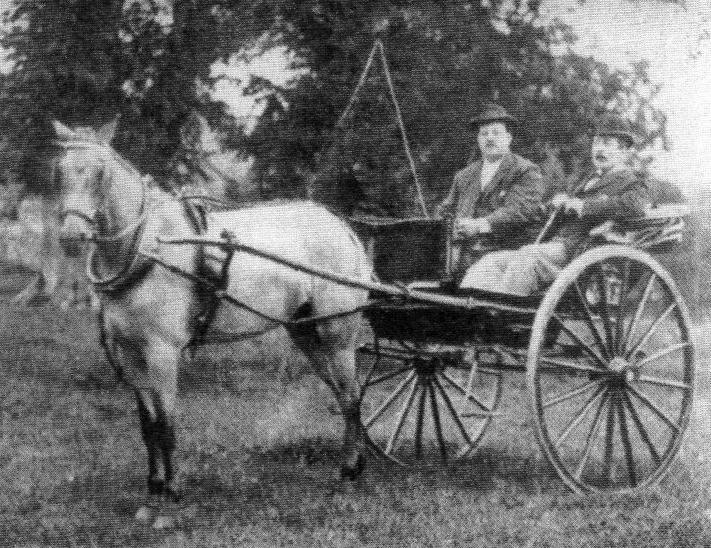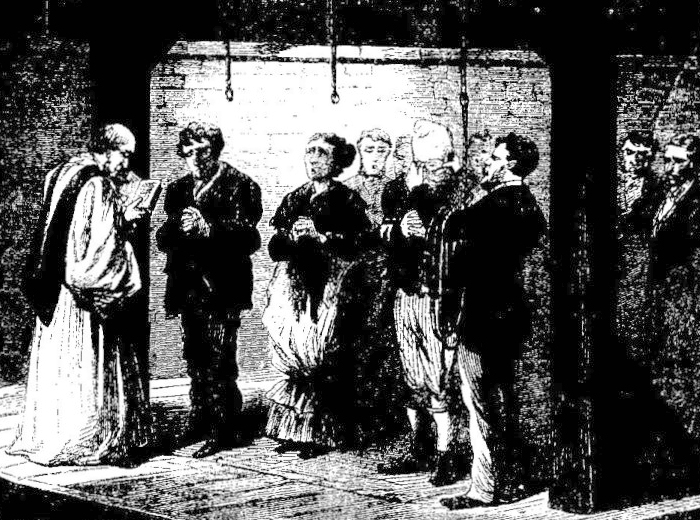|
Robert
Evans (Anderson) - “The Gentleman hangman.”
|
Robert
Evans was born in Carmarthen in 1816, as the son of a successful
lawyer. He later studied and qualified to become a doctor
although he never actually practised medicine. In fact he
inherited sufficient money to be able to live comfortably without
working. In later life he adopted his mother’s maiden
name of Anderson, although he was still widely known as "Evans
the hangman". He is the man on the right in the photo
below.
 It
seems that like his mother, Robert was fascinated with executions and
offered his services as an assistant to William Calcraft, the
country’s chief executioner of the time. He reportedly
gave his fee to Calcraft for the privilege
of assisting him. This he did on at least three occasions, at the
hanging of Richard Spencer at Liverpool on the 8th of January 1873,
the execution of serial poisoner Mary Ann Cotton at Durham on the
24th of March 1873 and at Calcraft’s last execution at Newgate,
that of John Godwin in 1874.
It
seems that like his mother, Robert was fascinated with executions and
offered his services as an assistant to William Calcraft, the
country’s chief executioner of the time. He reportedly
gave his fee to Calcraft for the privilege
of assisting him. This he did on at least three occasions, at the
hanging of Richard Spencer at Liverpool on the 8th of January 1873,
the execution of serial poisoner Mary Ann Cotton at Durham on the
24th of March 1873 and at Calcraft’s last execution at Newgate,
that of John Godwin in 1874.
Evans
wrote a letter to the Home Secretary in September of 1883 which was
later published in The Times. It read in part - “So long
as it is the law of the land that criminals shall suffer death, I
submit that the dread punishment should be carried into effect by
respectable and skilful hands and should not, as has been too
frequently the case of late, be entrusted to any ignorant or brutish
person whom the love of gain and notoriety prompts to apply for the
performance of the office.”
After
Calcraft retired Evans, was able to act as principal executioner on
seven occasions in England in 1874 and 1875, although he denied
having applied to take over the position, for which William Marwood
was selected by the Home Office.
His
first job as principal was the hanging of 23 year old Thomas Corrigan
at Liverpool on the 5th of January 1874 for the murder of his mother,
Mary on Saturday the 1st of November 1873. The execution was
reportedly carried out efficiently although, given the short drop,
Corrigan struggled for a few moments after the bolt was drawn.
He
also carried out a treble hanging in the open courtyard of Gloucester
prison on the 12th of January 1874, when 31 year old Mary Ann Barry
and her common law husband, Edwin Bailey, were executed for the
murder of his illegitimate child, together with Edward Butt who had
shot his girlfriend.
 Anderson
suggested that the platform of the gallows be mounted over a pit to
make it level with prison yard and this modification was made, a five
foot deep pit being dug in the airing yard for the purpose. The
platform was enclosed by a four foot high black calico screen.
The hangings took place at eight o’clock in the morning and
when the prisoners had been pinioned in their cells they were led out
in a procession, headed by the chaplain. Edward Butt and Edwin
were wearing suits and Mary Anne a long dress with lilac prints. She
was accompanied to the gallows by the matron of Gloucester Gaol, Miss
Marshall, whilst Edwin was accompanied by the Governor, Captain H. K.
Wilson. The rest of the party comprised the deputy governor,
the chaplain, the prison doctor and several warders. The three
condemned prisoners knelt on the platform and recited the Lords
Prayer with the chaplain before submitting to the final
preparations. Mary Anne was placed between the men on the trap,
their legs were tied and the white hoods placed over their heads,
followed by the nooses. The chaplain and the hangman shook
hands with each prisoner and then Anderson withdrew the bolt
releasing the trap doors and causing the prisoners to drop below the
level of the calico screen. The two men died almost without a
struggle but Mary Ann Barry, being of “spare build”
suffered for up to three minutes and Anderson had to press down upon
her shoulders to quicken her death.
Anderson
suggested that the platform of the gallows be mounted over a pit to
make it level with prison yard and this modification was made, a five
foot deep pit being dug in the airing yard for the purpose. The
platform was enclosed by a four foot high black calico screen.
The hangings took place at eight o’clock in the morning and
when the prisoners had been pinioned in their cells they were led out
in a procession, headed by the chaplain. Edward Butt and Edwin
were wearing suits and Mary Anne a long dress with lilac prints. She
was accompanied to the gallows by the matron of Gloucester Gaol, Miss
Marshall, whilst Edwin was accompanied by the Governor, Captain H. K.
Wilson. The rest of the party comprised the deputy governor,
the chaplain, the prison doctor and several warders. The three
condemned prisoners knelt on the platform and recited the Lords
Prayer with the chaplain before submitting to the final
preparations. Mary Anne was placed between the men on the trap,
their legs were tied and the white hoods placed over their heads,
followed by the nooses. The chaplain and the hangman shook
hands with each prisoner and then Anderson withdrew the bolt
releasing the trap doors and causing the prisoners to drop below the
level of the calico screen. The two men died almost without a
struggle but Mary Ann Barry, being of “spare build”
suffered for up to three minutes and Anderson had to press down upon
her shoulders to quicken her death.
Evans
said that Mary Anne had whispered to him on the gallows that she had
dreamt she would die like this. Mary Anne Barry became the last
woman to suffer death by the short drop method of hanging in Britain
and the last woman to be executed at Gloucester Gaol.
Evans
last English executions were those of 20 year old John M’Crave
and 17 year old Michael Mullen, two members of Liverpool’s
notorious “Cornermen gang” at Kirkdale Gaol on the 4th of
January 1875, for the murders of brothers Robert and Samuel Morgan.
With them on the gallows was William Worthington who had murdered his
wife. McCrave, the gang ringleader, is said to have
shown his true cowardice and became a gibbering wreck by the time of
his hanging. Reportedly Mullen remained calm and indifferent
throughout.
Evans’
last recorded execution was in Ireland, that of Joseph Poole,
a member of the Irish Republican Brotherhood, at
Richmond prison in Dublin on the 18th of December 1883. Poole’s
neck was reportedly broken by the drop and death was
“instantaneous”. Poole was convicted of the murder
of John Kenny who was suspected of being an informer against the
Fenians. This makes Evans unique in having successfully
transitioned from the short drop method of hanging to the long drop
method.
Evans
lived to 85, dying on the 26th of August 1901 and at the urging of
his only daughter was buried with a traditional ceremony rather than
being cremated which was his preference.
Back
to Contents
Page
 It
seems that like his mother, Robert was fascinated with executions and
offered his services as an assistant to William Calcraft, the
country’s chief executioner of the time. He reportedly
gave his fee to Calcraft for the privilege
of assisting him. This he did on at least three occasions, at the
hanging of Richard Spencer at Liverpool on the 8th of January 1873,
the execution of serial poisoner Mary Ann Cotton at Durham on the
24th of March 1873 and at Calcraft’s last execution at Newgate,
that of John Godwin in 1874.
It
seems that like his mother, Robert was fascinated with executions and
offered his services as an assistant to William Calcraft, the
country’s chief executioner of the time. He reportedly
gave his fee to Calcraft for the privilege
of assisting him. This he did on at least three occasions, at the
hanging of Richard Spencer at Liverpool on the 8th of January 1873,
the execution of serial poisoner Mary Ann Cotton at Durham on the
24th of March 1873 and at Calcraft’s last execution at Newgate,
that of John Godwin in 1874. Anderson
suggested that the platform of the gallows be mounted over a pit to
make it level with prison yard and this modification was made, a five
foot deep pit being dug in the airing yard for the purpose. The
platform was enclosed by a four foot high black calico screen.
The hangings took place at eight o’clock in the morning and
when the prisoners had been pinioned in their cells they were led out
in a procession, headed by the chaplain. Edward Butt and Edwin
were wearing suits and Mary Anne a long dress with lilac prints. She
was accompanied to the gallows by the matron of Gloucester Gaol, Miss
Marshall, whilst Edwin was accompanied by the Governor, Captain H. K.
Wilson. The rest of the party comprised the deputy governor,
the chaplain, the prison doctor and several warders. The three
condemned prisoners knelt on the platform and recited the Lords
Prayer with the chaplain before submitting to the final
preparations. Mary Anne was placed between the men on the trap,
their legs were tied and the white hoods placed over their heads,
followed by the nooses. The chaplain and the hangman shook
hands with each prisoner and then Anderson withdrew the bolt
releasing the trap doors and causing the prisoners to drop below the
level of the calico screen. The two men died almost without a
struggle but Mary Ann Barry, being of “spare build”
suffered for up to three minutes and Anderson had to press down upon
her shoulders to quicken her death.
Anderson
suggested that the platform of the gallows be mounted over a pit to
make it level with prison yard and this modification was made, a five
foot deep pit being dug in the airing yard for the purpose. The
platform was enclosed by a four foot high black calico screen.
The hangings took place at eight o’clock in the morning and
when the prisoners had been pinioned in their cells they were led out
in a procession, headed by the chaplain. Edward Butt and Edwin
were wearing suits and Mary Anne a long dress with lilac prints. She
was accompanied to the gallows by the matron of Gloucester Gaol, Miss
Marshall, whilst Edwin was accompanied by the Governor, Captain H. K.
Wilson. The rest of the party comprised the deputy governor,
the chaplain, the prison doctor and several warders. The three
condemned prisoners knelt on the platform and recited the Lords
Prayer with the chaplain before submitting to the final
preparations. Mary Anne was placed between the men on the trap,
their legs were tied and the white hoods placed over their heads,
followed by the nooses. The chaplain and the hangman shook
hands with each prisoner and then Anderson withdrew the bolt
releasing the trap doors and causing the prisoners to drop below the
level of the calico screen. The two men died almost without a
struggle but Mary Ann Barry, being of “spare build”
suffered for up to three minutes and Anderson had to press down upon
her shoulders to quicken her death.